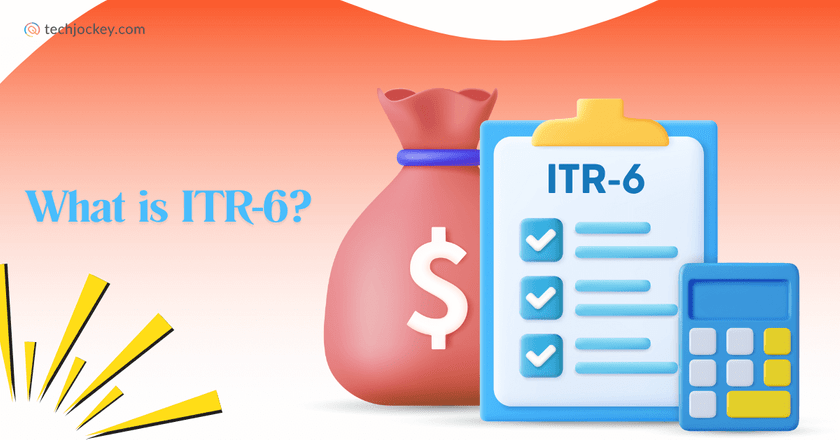What is ITR-6? Don’t File It Without Reading This First!

Filing income tax returns isn’t exactly a thrilling thing to do, but if you happen to run a company in India, ITR 6 is one form you cannot afford to ignore.
What is ITR 6? You ask. Well, it is the ITR form that companies that do not qualify for exemptions under Section 11 of the Income Tax Act are required to file. In simple terms, it is filed by businesses that are here to earn and not serve or do charity.
Let’s break down what ITR-6 means and find answers for burning questions like ITR-6 is for whom? to make tax filing easy for all the stakeholders involved.
What is ITR-6?
ITR-6 or Form 6 ITR, short for income tax return form 6, is designed for companies registered under the Companies Act, either the 2013 Act or the earlier 1956 Act, that are not eligible to claim exemption under Section 11. For those unaware, Section 11 covers any and every income derived from property held for charitable or religious purposes.
As such, private limited companies, public companies, Indian subsidiaries of foreign companies, and unlisted companies all use ITR-6 to report their income, claims, deductions, and compute taxes payable to the government.
Who Can File the ITR-6 Form?
All companies registered under the Companies Act 2013 or 1956 that do NOT claim exemption under Section 11 must file the ITR-6 form. This includes….
- Public and private limited companies
- Indian subsidiaries of foreign entities
- Non-listed companies
In other words, companies involved in charitable or religious activities whose income is exempt under Section 11 need not file ITR-6 as these do not fall under the ITR-6 applicability rule.
Companies liable for audit under Section 44AB of the Income Tax Act or any other law must provide audited accounts and the auditor’s report details. This includes filing Forms 3CA and 3CD for audit compliance alongside ITR-6.
Structure of ITR-6 Form
The ITR-6 form is one of the most detailed return forms, reflecting the complex financial reality of companies. It is structured in two main parts and numerous schedules that ensure efficient financial and tax reporting.
Part A: General and Financial Information
- Part A – General Information: Captures the company’s PAN, CIN, name, date of incorporation, residential status, turnover, nature of business (with codes), and other identifying details.
- Part A-BS – Balance Sheet: Reports the complete balance sheet as on March 31 of the fiscal year.
- Part A-BS Ind AS: For companies complying with Indian Accounting Standards (Ind AS), the Ind AS-compliant balance sheet is submitted.
- Part A-Manufacturing Account: Details of manufacturing operations, including raw materials, production, and cost of goods manufactured.
- Part A-Trading Account: Trading figures including opening stock, purchases, sales, and closing stock.
- Part A-P&L Account: Captures the profit and loss statement for the year.
- Part A-OI (Other Information): Includes details like depreciation claimed, audit information, and other disclosures.
- Part A-QD (Quantitative Details): Required for companies involved in manufacturing/trading, showing production and inventory data.
- Part Receipts and Payments: Applicable for companies under liquidation.
Part B: Income and Tax Computation
- Part B-TI (Total Income): Computation of total income from various heads: business/profession, house property, capital gains, and other sources.
- Part B-TTI (Tax Liability): Computation of tax liability, including surcharge, cess, and MAT (Minimum Alternate Tax).
- Part B-Verification: Declaration by the authorized signatory.
Part C: Schedules in ITR-6
Over 40 schedules form the backbone of ITR-6 filings, covering details like…
1. Income and Loss Computation Schedules
- Schedule HP (House Property Income): Captures income earned from house property, including rent received, municipal taxes paid, and interest on borrowed capital.
- Schedule BP (Business or Profession Income): Reports income from business or professional activities, including net profit, adjustments under tax laws, and depreciation.
- Schedule CG (Capital Gains): Details short-term and long-term capital gains, including special reporting under Section 112A and 115AD.
- Schedule OS (Other Sources): Includes income from dividends, interest, winnings from lotteries, and other miscellaneous sources.
- Schedule CYLA (Current Year’s Loss Adjustment): Adjusts losses incurred in the current year against income from other heads.
- Schedule BFLA (Brought Forward Loss Adjustment): Adjusts previously carried forward losses against the current year’s income.
- Schedule CFL (Carry Forward of Losses): Records losses that are eligible to be carried forward to future years.
- Schedule UD (Unabsorbed Depreciation): Tracks depreciation that could not be claimed in earlier years and is carried forward.
2. Deduction and Exemption Schedules
- Schedule VI-A (Chapter VI-A Deductions): Includes deductions under Sections 80C to 80U, such as LIC premiums, PF contributions, and medical insurance.
- Schedule 80G (Donations): Captures donations eligible for deduction, including details of the Donation Reference Number (DRN) from Form 10BD.
- Schedule 80-IA/80-IB/80-IC/80-ID/80-IE: Deductions for profits from infrastructure, industrial undertakings, and special category businesses.
- Schedule ESR (Expenditure on Scientific Research): Deductions for eligible scientific research expenses under Section 35.
3. Depreciation and Asset Schedules
- Schedule DPM (Depreciation on Plant & Machinery): Reports depreciation claimed on plant and machinery assets.
- Schedule DOA (Depreciation on Other Assets): Includes depreciation on buildings, furniture, vehicles, and intangibles.
- Schedule ER (Expenditure on Research): Captures capital and revenue expenditure on in-house R&D facilities.
4. Tax Computation and Credit Schedules
- Schedule MAT (Minimum Alternate Tax): Computes MAT liability under Section 115JB.
- Schedule MATC (MAT Credit): Records MAT credit available and carried forward.
- Schedule AMT / AMTC (Alternate Minimum Tax): Applicable for companies under AMT provisions (rarely used in ITR-6).
- Schedule TTI (Tax Liability on Total Income): Final computation of tax payable, including surcharge and cess.
- Schedule SI (Special Rate Income): Income taxed at special rates (e.g., lottery winnings, capital gains).
5. Foreign Income and Asset Schedules
- Schedule FSI (Foreign Source Income): Reports income earned from foreign sources.
- Schedule TR (Tax Relief): Claims relief under Sections 90, 90A, and 91 for taxes paid abroad.
- Schedule FA (Foreign Assets): Mandatory disclosure of foreign bank accounts, assets, and financial interests.
6. Audit and Compliance Schedules
- Schedule ICDS (Income Computation and Disclosure Standards): Adjustments required under ICDS provisions.
- Schedule 10-IB / 10-IC / 10-ID: For companies opting for concessional tax regimes under Sections 115BA, 115BAA, and 115BAB.
- Schedule SH-1 (Shareholding Pattern): Details of shareholders holding 10% or more in unlisted companies.
- Schedule AL-1 (Assets and Liabilities): Disclosure of assets and liabilities for unlisted companies.
- Schedule FD (Funds Details): Captures details of funds received and utilized (if applicable).
7. Tax Payment and TDS/TCS Schedules
- Schedule TDS (Tax Deducted at Source): Details of TDS claimed, matched with Form 26AS.
- Schedule TCS (Tax Collected at Source): Reports TCS collected and claimed.
- Schedule IT (Advance Tax and Self-Assessment Tax): Includes payments made during the year.
8. Other Disclosure Schedules
- Schedule EI (Exempt Income): Reports income exempt from tax, for example, agricultural income.
- Schedule AIR (Annual Information Return): Captures high-value transactions reported by third parties.
- Schedule PTI (Pass Through Income): Income received from business trusts or investment funds.
- Schedule TPSA (Transfer Pricing Secondary Adjustment): Details of secondary adjustments under transfer pricing rules.
- Schedule TPS (Transfer Pricing Summary): Summary of international and specified domestic transactions.
Key Changes in ITR-6 Form for AY 2025-26
The Income Tax Department has introduced several significant changes in Form 6 ITR for the Assessment Year 2025-26. Some of them are listed below for your convenience…
- Capital Gains Reporting: Better segregation of capital gains accruing before and after July 23, 2024, aligning with the Finance Act, 2024 amendments.
- Buyback Loss Treatment: Capital losses from share buybacks are allowed if the related dividend income is disclosed under Income from Other Sources.
- Section 44BBC Added: Reference included for presumptive taxation concerning cruise shipping businesses.
- Schedule BP Update: Foreign companies must declare income from rough diamond sales of 4% or more gross receipts under Rule 10TIA.
- Interest Deduction Details (Section 24b): Additional filing details for housing loan interest deductions.
- Schedule-TDS Revision: New fields for applicable TDS section codes for accurate data linkage with TDS returns.
- Environmental, Social, Governance (ESG) and Corporate Social Responsibility (CSR) Details: New disclosures required for companies preparing ESG reports and CSR compliance under Section 135 of the Companies Act.
- Foreign Remittance Reporting: Mandatory PAN and country-wise details under the Liberalised Remittance Scheme (LRS) for outward remittance disclosures.
- Audit Trail Disclosures: Companies must declare if books of accounts are maintained using audit-trail-enabled software and if tampering.
- Startup Recognition Details: Capturing details for startups registered under DPIIT, availing Section 80-IAC deductions.
- Mandatory Disclosures on MSME dues, online gaming winnings, dividend income from International Financial Services Centres (IFSC), and tax audit reasons under Section 44AB.
Due Date ITR-6 Filing in FY 2024-25
For companies not required to get audits, the ITR-6 last date of filing is 30th November of the Assessment Year. For companies subject to tax audits under Section 44AB or other laws, on the other hand, the last date is 31st October of the Assessment Year.
Adhering to these ITR-6 due dates is essential for companies to maintain tax discipline. Late filing can incur interest penalties under Section 234A, 234B, and 234C, and late fees under Section 234F.
Note: Verification through digital signatures is mandatory to authenticate the filings.
Also, September 15 is the extended ITR filing deadline for non-audit taxpayers like individuals and HUFs. It does not apply to companies filing ITR-6.
Conclusion
So, what is ITR-6, again? Repeat after us, the income tax return form 6 is a tax document that reflects a company’s financial transparency and legal compliance. Filing it on time helps avoid penalties and shows your business is serious about staying on the right side of the law.
If you are looking for an income tax software to simplify your ITR-6 filing process, get in touch with the Techjockey product team today and end the hunt.
FAQs
Can ITR-6 be filed online?
Yes, ITR-6 can only be filed online through the Income Tax e-Filing portal. Companies must use a Digital Signature Certificate (DSC) to verify the return, because other methods like Aadhaar OTP or EVC are not allowed.
What are preliminary expenses in ITR-6?
Preliminary expenses in ITR-6 refer to costs incurred before starting a business or while expanding it. These include feasibility reports, legal charges, registration fees, and share issue expenses.
Yashika Aneja is a Senior Content Writer at Techjockey, with over 5 years of experience in content creation and management. From writing about normal everyday affairs to profound fact-based stories on wide-ranging themes, including environment, technology, education, politics, social media, travel, lifestyle so on and so forth, she... Read more




























